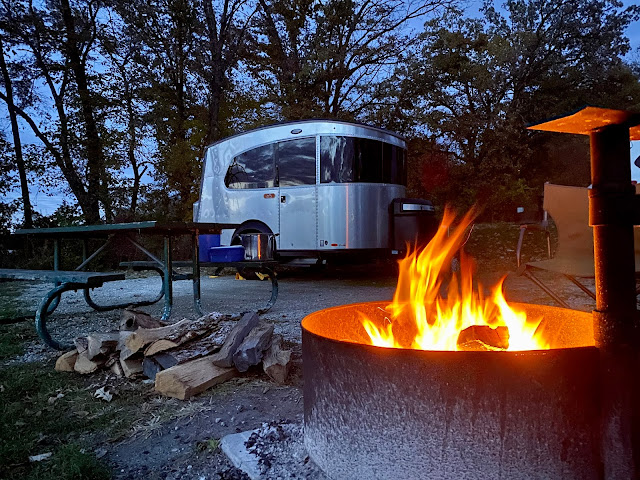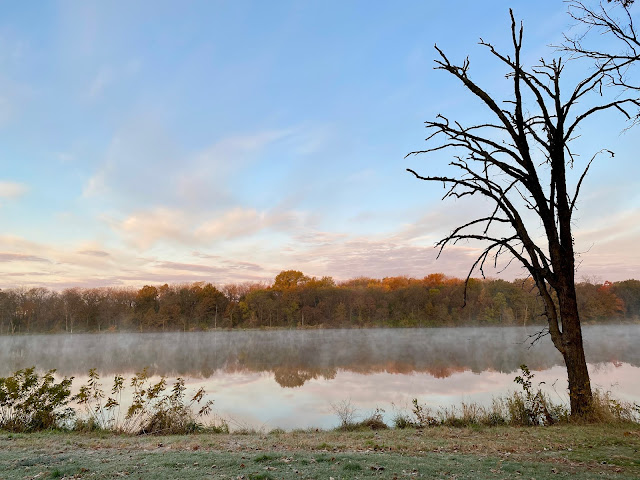Last night before bed, I brushed my teeth and then went outside my
Airstream Basecamp to rinse my mouth and my toothbrush. It was an old-school camping routine, one that I had adopted when camping with my standy tiny trailer that had no plumbing. Spit outside after brushing my teeth. Wake up in the morning and crack the ice in the water bucket outside, then rinse my face. Sit by the fire in the evening and read with a headlamp. Those are good memories, and my last three days of camping at
Lake Darling State Park just reinforced those good memories and the practical, simple camping practices I learned while tiny trailer camping.
This week brought the first frosts of the year with temperatures in the mid-20s, so prior to this trip I winterized the Basecamp, draining tanks and flushing water lines with RV anti-freeze. It was my first time winterizing the Basecamp (or any RV), so I suppose I'll have to wait till next spring to find out if I did everything correctly. However, now that the rig is winterized, it has become in a way a larger, more grand version of my little
RTTC Polar Bear--a small trailer that required many camping necessities to be done outside or, if inside, in a modified manner. Winter temperatures also necessitate some acknowledgement of condensation factors, which especially means being careful with cooking. I enjoyed my old-school camping trip, though, and appreciated how the little Airstream Basecamp (as opposed to a tiny trailer) was easily adapted to a simpler style of winterized camping. The transformation can be described with just a few significant points of change.
- No running water. Flush toilet, shower, and kitchen sink are all now shut down. Our toilet is now a form of military, dry-bag toilet, such as I reviewed with the Cleanwaste Portable Toilet in an earlier article. When camping, my wife and I bring our own filtered drinking water from home, so that hasn't changed. As for water for bathing and dishwashing, we have a bucket and make use of the faucts at campgrounds.
- Heating. Winterizing had no effect on the Basecamp's efficient Truma furnace, other than the fact that the water heater is drained and isolated from anti-freeze. There still is that winter camping experience of finding that magic balance point between too hot and too cold, especially with sleeping. Also, the Basecamp's thermostat on the wall near the door is significantly at variance with the actual temperature in the camper. I usually have to set it somewhere between 10-15 degrees cooler than the actual temperature I want. Last night, for instance, I slept with the thermostat set at 45 degrees.
- Propane cook stove. The Dometic propane gas stove works just fine; however, I am aware that burning propane creates moisture as a by-product, which makes me sometimes choose to cook outside. Also, since the camper in more buttoned up in colder weather, smells tend to linger longer.
- A cozy campfire. Summer campfires, at least in Iowa, are often just symbolic and something I skip. When it's in the 80s and it's humid, I don't need a campfire unless it's a smoky one that keeps away the mosquitoes. Cold-weather camping, though, really warms the heart regarding the idea of having a campfire--and that's probably because a winter campfire literally warms the heart! The campfire becomes a place to enjoy the heat of the burning wood while also enjoying the beauty of the cold weather. Sometimes that a bit of a paradox because the side toward the fire is a bit too hot and the side away from the fire is a bit too cold. A fire keeps us outside for a longer time when the weather has turned cold.
Winterized camping in my modern Airstream Basecamp has that old school vibe--more outside time for camp chores and routines, but with the inside of the camper available when I just need a break and a little comfortable time. As for when I winterize, I chose to do so early. Forecasts indicate I probably could have waited until late November this year if I were willing to turn on tank heaters and to keep the camper warm inside, even when parked at home. That's why I recently had a 30-amp RV outlet wired for my garage and driveway area. However, a lot of campers who don't winterize early are traveling south, and the cold weather is a temporary inconvenience. For me here in Iowa, the certainty is that it's now frosting, then it's going to get cold--and then it's going to get damn cold and stay that way for several months. Rather than play freeze-the-pipes roulette, I just winterized and got it over with. What I've lost in convenience, I've gained by skipping the worry.

At this point, I can camp for as long as the roads are safe, as long as I'm careful about managing condensation in the cold weather. (See the article "
Minimizing Condensation in a Teardrop or Tiny Trailer") What I've learned from reading online posts from other small trailer owners is that your trailer doesn't have to be tiny to have a condensation issue. Fortunately, condensation remedies are science-based and fairly straightforward. Usually sometime in the winter, though, we have an Iowa combination ice-and-snow storm which dumps its slippery precipitation and then keeps it frozen for weeks to months. After such a storm, even if the roads are cleared, campsites are locked up with the snow and ice, last year for at least a couple of months.
Until then, my little trailer is a tiny trailer mansion--with its own room for the toilet, with a kitchen, and with a built-in furnace. Sometimes I just walk around in my trailer, thinking to myself, "Look, I can walk around, not just one step forward and one step back!" This will be our first fall and winter season of camping with the Basecamp, and I'm looking forward to it.




No comments:
Post a Comment